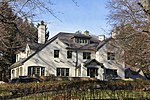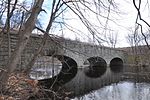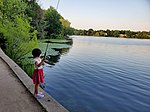Newton Highlands station
Buildings and structures in Newton, MassachusettsFormer Boston and Albany Railroad stationsGreen Line (MBTA) stationsRailway stations in Middlesex County, MassachusettsRailway stations in the United States opened in 1852 ... and 1 more
Railway stations in the United States opened in 1959

Newton Highlands station is a surface-level light rail station located in Newton, Massachusetts on the Green Line D branch of the Massachusetts Bay Transportation Authority.
Excerpt from the Wikipedia article Newton Highlands station (License: CC BY-SA 3.0, Authors, Images).Newton Highlands station
Station Avenue, Newton Newton Highlands
Geographical coordinates (GPS) Address Nearby Places Show on map
Geographical coordinates (GPS)
| Latitude | Longitude |
|---|---|
| N 42.3225 ° | E -71.205555555556 ° |
Address
Station Avenue 18
02461 Newton, Newton Highlands
Massachusetts, United States
Open on Google Maps










